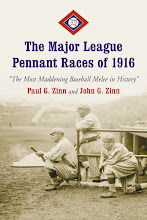
In writing the latest version of the Brooklyn Dodgers much lamented departure from Brooklyn in 1957-58, Michael D'Antonio had full access to Walter O'Malley's papers and related documents - apparently the first writer to have used this resource. This material enables him to more fully develop the revisionist version which I read for the first time in Michael Shapiro's, "The Last Good Season" - the story of the 1956 baseball season, my first season of active baseball interest. I use the word revisionist in a non-judgemental way, this piece of history like any other should be subject to revision if new material and perspectives become available.
According to this version, the true villain of the piece is not O'Malley, but rather Robert Moses, a perhaps even more controversial figure than O'Malley. For decades Moses who never held elective office and seldom, if ever, paid government positions was the final authority on all development projects in New York City. According to his biographer, Robert Caro, the primary reason that Moses had this power was his ability to get things done. That is, the failure of the elected officials to build highways, housing, parks etc, enabled someone who could, to acquire and hold this vast power over the city. Certainly the picture painted in D'Antonio's book confirms this view, Mayor Robert Wagner and other government officials seem singularly inept in dealing with the situation. It is hard to visualize today how a New York City mayor could survive allowing sports institutions like the Dodgers and Giants to leave town.
Some of the blame is also laid at the feet (perhaps literally) of the Brooklyn fans who didn't go or stopped going to Ebbets Field - one particularly striking image is empty seats at the sixth game of the 1952 World Series when the Dodgers had a chance to win their first World's Championship. Given the success of the Dodgers in the late 1940's and 1950's, declining or static attendance is hard to understand. But this is also where the revisionist story breaks down to some degree. One reason that O'Malley has been, and probably always will be, criticized for moving the Dodgers is that his was a preemptive strike.
With, I think, one exception every other shift of a franchise was due to years of poor attendance and little or no fan interest - the Giants are a striking example. While Dodgers attendance may have been disappointing or falling behind the competition, the team was still very successful financially. The moved was more based on potential losses and a future lack of competitiveness and that will always be hard to justify. Ironically the only other example, I can think of, where a team abandoned a city where it was doing well was the Braves move from Milwaukee to Atlanta. Ironic because it was the success of the original move from Boston to Milwaukee that escalated O'Malley's belief that he needed a new stadium.
Another problem which is offered with the benefit of hindsight is that it appears that the possibility of rebuilding or renovating Ebbets Field may not have gotten adequate consideration. Certainly it is not considered in any depth in this book or others on the subject. In addition to the inadequacies of the stadium itself, the pressing issue was supposed to be the lack of parking that would deter all of those Brooklynites moving to the suburbs from returning for games. Yet two of today's most successful stadiums are Fenway Park in Boston and Wrigley Field in Chicago, both built in the same era, both with very little parking. Indeed I have stopped driving to Mets games even though there is plenty of parking so this may not have been the crucial issue it seemed at the time. One wonders what could have happened at Ebbets Field had some real creativity been applied to that option - the issue of renovating old parks vs building new ones will be the subject of a further post.
As I read "Forever Blue," I thought that there wasn't much in it that I hadn't read in Shapiro's book. One exception was the difficulty O'Malley had building Dodgers Stadium which if it was in the other book, I don't remember it. Certainly the owner of the Dodgers found that to be no easy task, but at least he had some political leaders who stood up for him and his team. Yet in spite of what was not a lot of new material and even with knowing the ending, the book held my attention. D'Antonio uses the material from the O'Malley archives to give a fuller, more balanced picture of this controversial figure who becomes far more human than the unfortunate caricatures developed over the years. It is certainly a book for every Dodger fan, Brooklyn or Los Angeles and for anyone interested in the history of the game.



No comments:
Post a Comment